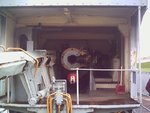parsifal
Colonel
Another online history had this to say on Group 2s assault of trondheim:
"TRONDHEIM
Against Trondheim sailed Gruppe 2 of the German invasion fleet commanded by Kpt.z.S. Hellmuth Heye. Gruppe 2 was to land 1,700 men of the elite Gebirgs-Regiment 138/3.Gebirgs-Division. The ships of Gruppe 2 were as follows:
Schwere Kreuzer Admiral Hipper 17209
Zerstorer Paul Jacobi (Z5) 17474
Zerstorer Theodor Riedel (Z6) 01923
Zerstorer Bruno Heinemann (Z8) 13029
Zerstorer Friedrich Eckoldt (Z16) 03772
Two U-boats were also allocated to the attack Trondheim.
The last of the five main Norwegian naval fortification was located on the approaches to Trondheim at Agdenes on the bank opposite the Agdenes lighthouse. Here was located one battery of 2 x 210mm guns, 3 x 150mm guns, and 2 x 65mm guns. A second battery of 2 x 210mm guns, 2 x 150mm guns, and 3 x 65mm guns was also on this bank. On the other bank, just inland of the lighthouse, was located 2 x 150mm guns. During the German attack, a blocking position was established near the second battery listed above, with 35 men manning nine tripod-mounted Colt-Browning machineguns, which successfully withstood five attacks by a 500-man German landing force. In addition to these fortifications, the Norwegian Navy also had in the Trondheim Fjord a number of small vessels including the minelayer FROYA.
Despite damage received at sea April 8th, HIPPER engaged the Norwegian gunners while the four destroyers boldly ran the batteries, speeding through at 25 knots (equivalent to a land speed of 28 mph) on a course calculated to minimize the time they spent under the guns. A shell from HIPPER severed the electric cable which powered the two Norwegian searchlights, and the slow rate of fire of the old Norwegian guns-- three salvos every two minutes-- also helped the plan succeed. One destroyer was hit in the effort. Although the Norwegian Navy forts at the entrance to the Fjord held out for eleven hours, Trondheim itself was captured with little difficulty. In the fighting the Norwegian fortress garrisons lost only one man killed and two wounded. German troops who attacked the blocking position (35 men and 9 mgs, see above, Section C) established by Capt. Lange outside the fort he commanded suffered 22 casualties. Minelayer FROYA was captured".
Source:
The Invasion of Norway
I guess if you count knocking out the electricity supply for the searchlights, then Hippers effort counts as knocking out the battery.....most people would not say that however
"TRONDHEIM
Against Trondheim sailed Gruppe 2 of the German invasion fleet commanded by Kpt.z.S. Hellmuth Heye. Gruppe 2 was to land 1,700 men of the elite Gebirgs-Regiment 138/3.Gebirgs-Division. The ships of Gruppe 2 were as follows:
Schwere Kreuzer Admiral Hipper 17209
Zerstorer Paul Jacobi (Z5) 17474
Zerstorer Theodor Riedel (Z6) 01923
Zerstorer Bruno Heinemann (Z8) 13029
Zerstorer Friedrich Eckoldt (Z16) 03772
Two U-boats were also allocated to the attack Trondheim.
The last of the five main Norwegian naval fortification was located on the approaches to Trondheim at Agdenes on the bank opposite the Agdenes lighthouse. Here was located one battery of 2 x 210mm guns, 3 x 150mm guns, and 2 x 65mm guns. A second battery of 2 x 210mm guns, 2 x 150mm guns, and 3 x 65mm guns was also on this bank. On the other bank, just inland of the lighthouse, was located 2 x 150mm guns. During the German attack, a blocking position was established near the second battery listed above, with 35 men manning nine tripod-mounted Colt-Browning machineguns, which successfully withstood five attacks by a 500-man German landing force. In addition to these fortifications, the Norwegian Navy also had in the Trondheim Fjord a number of small vessels including the minelayer FROYA.
Despite damage received at sea April 8th, HIPPER engaged the Norwegian gunners while the four destroyers boldly ran the batteries, speeding through at 25 knots (equivalent to a land speed of 28 mph) on a course calculated to minimize the time they spent under the guns. A shell from HIPPER severed the electric cable which powered the two Norwegian searchlights, and the slow rate of fire of the old Norwegian guns-- three salvos every two minutes-- also helped the plan succeed. One destroyer was hit in the effort. Although the Norwegian Navy forts at the entrance to the Fjord held out for eleven hours, Trondheim itself was captured with little difficulty. In the fighting the Norwegian fortress garrisons lost only one man killed and two wounded. German troops who attacked the blocking position (35 men and 9 mgs, see above, Section C) established by Capt. Lange outside the fort he commanded suffered 22 casualties. Minelayer FROYA was captured".
Source:
The Invasion of Norway
I guess if you count knocking out the electricity supply for the searchlights, then Hippers effort counts as knocking out the battery.....most people would not say that however

